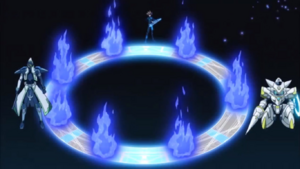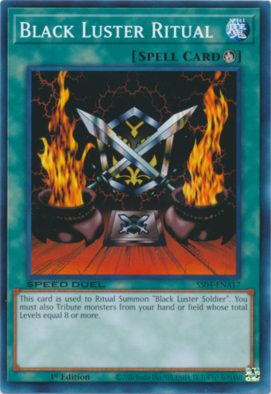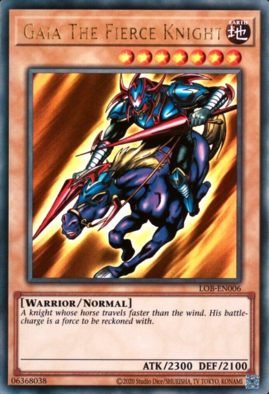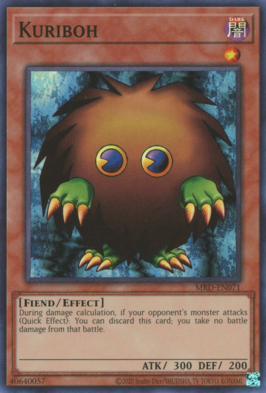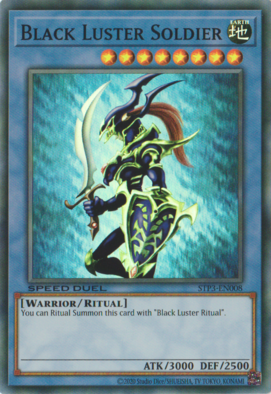Ritual Summon
A Ritual Summon (
Ritual Summons usually require Tributes (from your hand or field) greater than or equal to, or sometimes strictly equal to, the Level of the Ritual Monster that is being Summoned. These Tributes are performed as part of the Ritual Spell Card's effect resolution, rather than as a cost. [1]
Archetypes that focus on Ritual Summoning include "Gishki", "Prediction Princess", "Black Luster Soldier", "Drytron", "Cyber Angel", "Voiceless Voice", "Nouvelles", "Mikanko", "Megalith", "Impcantation", "Libromancer", "Vendread", "Shinobird" and "Nekroz".
Contents
Mechanics[edit]
A Ritual Summon is always performed by a card effect. When an effect that performs a Ritual Summon resolves, the player must perform the actions described in the effect, which usually involves moving other monsters from one location to another, then the player will Special Summon the Ritual Monster from a specified location face-up to an unoccupied Main Monster Zone.
Usually, a card effect that performs a Ritual Summon is a card effect from a Ritual Spell Card, involves Tributing monsters from the player's hand and/or field whose total Levels equal or exceed the Level of the Ritual Monster, and Ritual Summons the Ritual Monster from the hand.
The player cannot use more monsters than necessary to perform a Ritual Summon.[2][3][4] If any monster among the used monsters could be removed, but the Ritual Summon's requirement would still be met, then that monster cannot be used.
Face-down monsters can be Tributed for a Ritual Summon, unless the card text specifies otherwise (such as "Forbidden Arts of the Gishki").[5] If a monster has an effect that allows it to be used as the entire monster requirement for the Ritual Summon (such as "Ritual Raven"), that effect can be applied when it is used for a Ritual Summon even if it is face-down.[5] If the player can Tribute an opponent's face-down monster due to a card effect (such as "Soul Exchange"), it cannot be used for a Ritual Summon because its Level is unknown.[6]
When a card or effect that Ritual Summons resolves, if the requirement cannot be met or the Ritual Monster cannot be Ritual Summoned, no Ritual Summon occurs, nor is any action taken for the Ritual Summon's requirement.[7][8] For example, if a player cannot Special Summon when resolving a Ritual Spell that Tributes monsters, no monsters are Tributed.
If the player resolves a Ritual Summoning effect when all of their Main Monster Zones are occupied, the effect can still successfully resolve if it uses at least one of the monsters in these zones in the Ritual Summon and removes it from the field, so that there is an available zone when the Ritual Monster is Summoned. If the effect is unable to do so, then it will resolve without effect.
Ritual Summoning effect variations[edit]
As Ritual Summons are always performed by card effects, the specific actions involved in Ritual Summoning are exclusively determined by the individual effects that do so, meaning that their details can vary significantly.
- Ritual Summoning effects can be from Ritual Spell Cards, or can be from non-Ritual Spell Cards. Examples:
- Ritual Summoning effects can Ritual Summon from the hand, or can Ritual Summon from other specified locations. Examples:
- "Nekroz Cycle" (Ritual Summons from Graveyard)
- "Renewal of the World" (Ritual Summons banished monster)
- "High Ritual Art" (Ritual Summons from Deck)
- Ritual Summoning effect requirements can involve Tributing monsters from the player's hand or field, or can require other actions involving moving monsters in other locations. Examples:
- "Nekroz Kaleidoscope" (Ritual Summons by sending monsters from the player's Extra Deck to the GY)
- "Advanced Ritual Art" (Ritual Summons by sending monsters from the player's Deck to the GY)
- "Nekroz Mirror" (Ritual Summons by banishing monsters from the player's GY)
- "Forbidden Arts of the Gishki" (Ritual Summons by Tributing monsters on either side of the field)
- Ritual Summoning effect requirements can involve using/moving monsters with Levels to meet the Ritual Monster's own Level, or can require other monster parameters, or no monster parameters beyond the status of being a monster. Examples:
- "Meteonis Drytron" (Ritual Summons by tributing monsters whose total ATK meets the ATK of the Ritual Monster)
- "Gishki Nekromirror" (Ritual Summons by tributing 1 opposing face-up monster, but otherwise imposes no requirements on the monster)
- Ritual Summoning effect requirements can involve no monsters at all. The current sole example of such an effect is "Gishki Photomirror", which Ritual Summons by paying LP.
Interactions with effects[edit]
- Some monsters have effects that allow the player to use them as the entire monster movement requirement for a Ritual Summon that requires Levels, regardless of their Level and the required Level. (e.g.: "Ritual Raven", "Gishki Shadow")
- Some cards have effects that allow the player to perform alternate actions on Monster Cards to fulfill the requirements for a Ritual Summon that requires monsters, regardless of the original action specified. Examples:
- "Djinn Releaser of Rituals" (Lets the player banish a monster from the GY instead)
- "Drytron Mu Beta Fafnir" (Lets the player detach Xyz Materials instead)
- "Emperor Tanuki's Critter Count" (Lets the player send 1 monster from their Extra Deck to the GY instead)
Example[edit]
Ritual Spell ("Black Luster Ritual")
+ a Level 7 Tribute ("Gaia The Fierce Knight")
+ a Level 1 Tribute ("Kuriboh")
= the corresponding Ritual Monster ("Black Luster Soldier")
Appearance[edit]
Manga[edit]
Yu-Gi-Oh! (manga)[edit]
In the original Yu-Gi-Oh! manga, besides the needed tributes, Ritual Summon also requires a proper monster to become the vessel for the Ritual Monster. For example, when Yugi used "Black Magic Ritual" and "Black Luster Ritual", he used "Gaia The Fierce Knight" and "Dark Magician" to summon "Black Luster Soldier" and "Magician of Black Chaos", respectively. Similarly, Maximillion Pegasus used "Dark-Eyes Illusionist" to summon "Relinquished".
Anime[edit]
Yu-Gi-Oh! ARC-V[edit]
Prior to Yu-Gi-Oh! ARC-V, there were no common animation patterns for Ritual Summoning. In ARC-V, when a Ritual Card is activated, the altar depicted on it appears on the field, and then the Tributed monsters turn into a number of flames (equal to their individual Levels) before positioning themselves on the altar. A pillar of fire rises from the altar and explodes in the sky, after which the Ritual Monster descends from the sky.
Yu-Gi-Oh! VRAINS[edit]
In Yu-Gi-Oh! VRAINS, a circle is formed and the Tributed monsters turn into a number of flames (equal to their individual Levels) and disintegrate into the sky, before entering the circle. Then an explosion occurs, and the Ritual Monster is finally created.
Trivia[edit]
- Yu-Gi-Oh! 5D's is the only Yu-Gi-Oh! anime series to feature no on-screen Ritual Summons, although one did appear in the Yu-Gi-Oh! 5D's manga.
References[edit]
- ↑ "Individual Card Rulings [L-O]". UDE. Lich Lord, King of the Underworld. Archived from the original on 20 February 2009. Retrieved 12 December 2015.
- ↑ Jerome McHale (3 February 2010). "Absolute Powerforce Preview: Djinn Disserere of Rituals". Konami. Retrieved 12 December 2015.
When you Ritual Summon a monster, you need to Tribute monsters whose total Levels [sic] at least the Level of the monster you want to Summon, but you aren’t allowed to “overpay.” For example, if your Ritual monster [sic] is Level 7, you can Tribute a Level 5 and a Level 3 monster. You could not Tribute a third monster for that Ritual Summon.
- ↑ Scott Miller (23 February 2009). "How Ritual Summons Work". Konami. Retrieved 12 December 2015.
Some Ritual Spells let you go over that number, others require the Levels of the Tributes to exactly match the Level of the Ritual Monster. No matter what, if you have already selected enough monsters to fulfil [sic] the requirement, you can’t Tribute any extra ones.
- ↑ Scott Miller (6 January 2015). "Secrets of Eternity: Netherlord of the Flies". Konami. Retrieved 12 December 2015.
Remember, though, that you cannot overpay by Tributing more monsters than necessary to meet the “total Level 6 or more” requirement.
- ↑ a b "Individual Card Rulings [P-R]". UDE. Ritual Raven. Archived from the original on 20 February 2009. Retrieved 12 December 2015.
- ↑ "Individual Card Rulings [S-T]". UDE. Soul Exchange. Archived from the original on 20 February 2009. Retrieved 12 December 2015.
You can target a face-down monster, but you cannot Tribute it for a Ritual Summon or for “Metamorphosis” because you do not know its Level.
- ↑ "Individual Card Rulings [L-O]". UDE. Mask of Restrict. Archived from the original on 20 February 2009. Retrieved 12 December 2015.
- ↑ "Individual Card Rulings [L-O]". UDE. Lightforce Sword. Archived from the original on 20 February 2009. Retrieved 12 December 2015.
